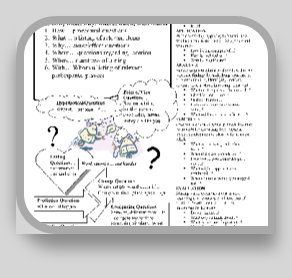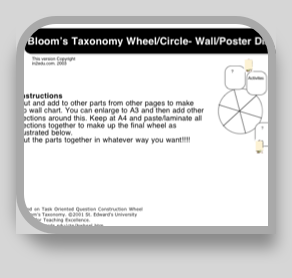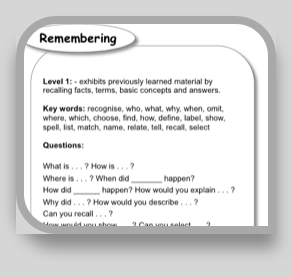
-

Questions & Blooms
Essential questions
-

Blooms Taxonomy
Chart, wheel and more
-

Blooms Questions
Taxonomy posters

These are our Blooms Taxonomy metacognition resources. Click on the free resource that interests you in the right hand column.
Tips for Thinking about Thinking
Benjamin Bloom (1956) developed a classification of levels of intellectual behavior in learning. This taxonomy contained three overlapping domains: the cognitive, psychomotor, and affective. Within the cognitive domain, he identified six levels: knowledge, comprehension, application, analysis, synthesis, and evaluation. These domains and levels are still useful today as you develop the critical thinking skills of your students. Many resources combine Bloom's reasoning with other flavours of thinking (i.e. deBono)
Critical Thinking
Critical thinking involves logical thinking and reasoning including skills such as comparison, classification, sequencing, cause/effect, patterning, webbing, analogies, deductive and inductive reasoning, forecasting, planning, hypothesizing, and critiquing.
Creative thinking involves creating something new or original. It involves the skills of flexibility, originality, fluency, elaboration, brainstorming, modification, imagery, associative thinking, attribute listing, metaphorical thinking, forced relationships. The aim of creative thinking is to stimulate curiosity and promote divergence.
While critical thinking can be thought of as more left-brain and creative thinking more right brain, they both involve "thinking." When we talk about HOTS "higher-order thinking skills" we're concentrating on the top three levels of Bloom's Taxonomy: analysis, synthesis, and evaluation.
Other resources you may be interested in:
Tips for Thinking about Thinking
Benjamin Bloom (1956) developed a classification of levels of intellectual behavior in learning. This taxonomy contained three overlapping domains: the cognitive, psychomotor, and affective. Within the cognitive domain, he identified six levels: knowledge, comprehension, application, analysis, synthesis, and evaluation. These domains and levels are still useful today as you develop the critical thinking skills of your students. Many resources combine Bloom's reasoning with other flavours of thinking (i.e. deBono)
Critical Thinking
Critical thinking involves logical thinking and reasoning including skills such as comparison, classification, sequencing, cause/effect, patterning, webbing, analogies, deductive and inductive reasoning, forecasting, planning, hypothesizing, and critiquing.
Creative thinking involves creating something new or original. It involves the skills of flexibility, originality, fluency, elaboration, brainstorming, modification, imagery, associative thinking, attribute listing, metaphorical thinking, forced relationships. The aim of creative thinking is to stimulate curiosity and promote divergence.
While critical thinking can be thought of as more left-brain and creative thinking more right brain, they both involve "thinking." When we talk about HOTS "higher-order thinking skills" we're concentrating on the top three levels of Bloom's Taxonomy: analysis, synthesis, and evaluation.
Other resources you may be interested in:
